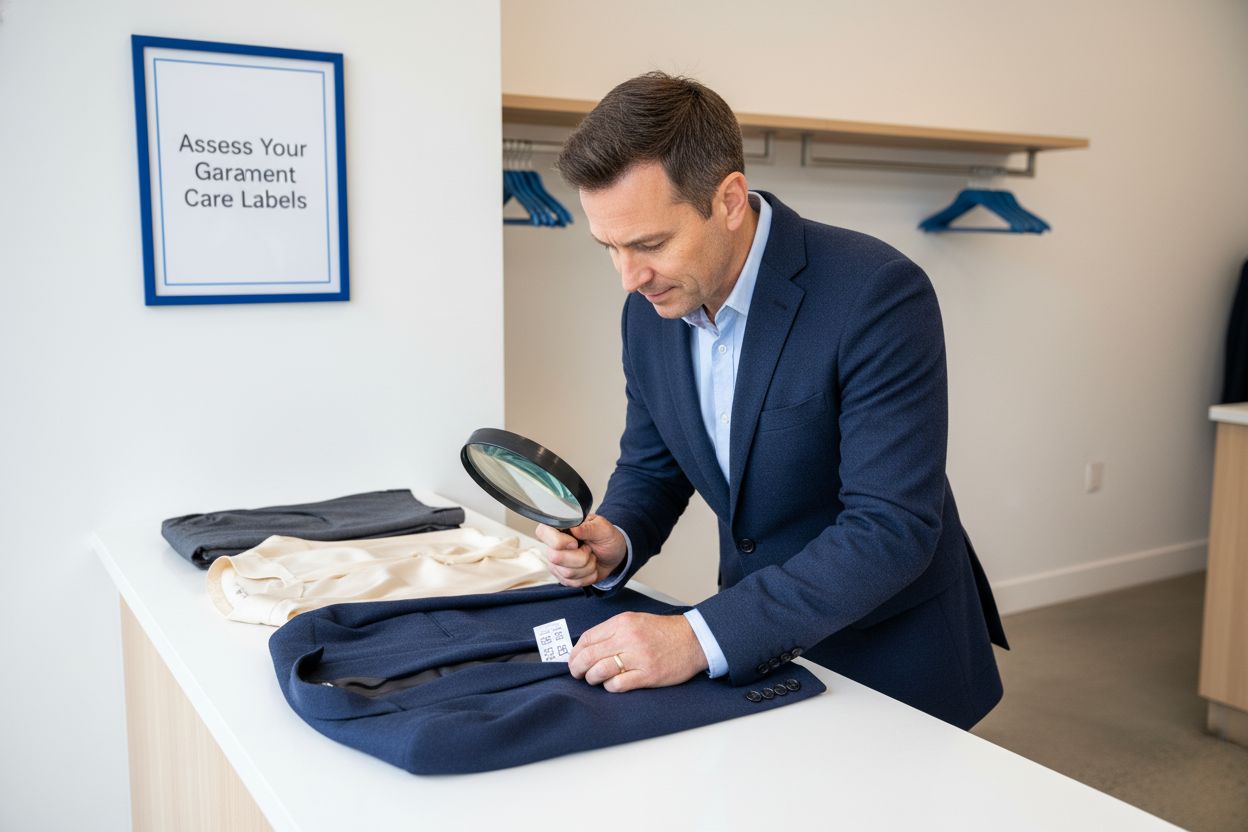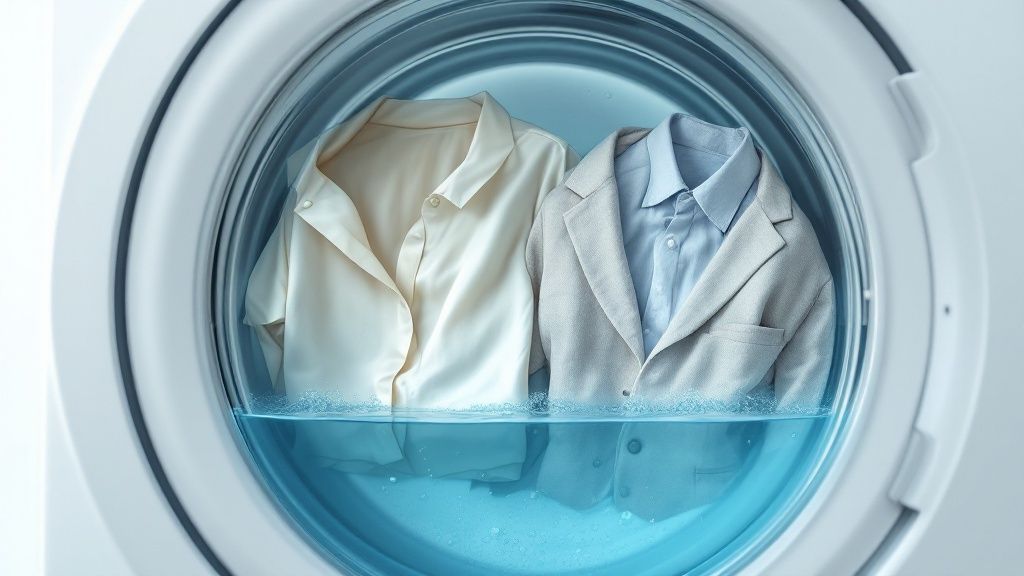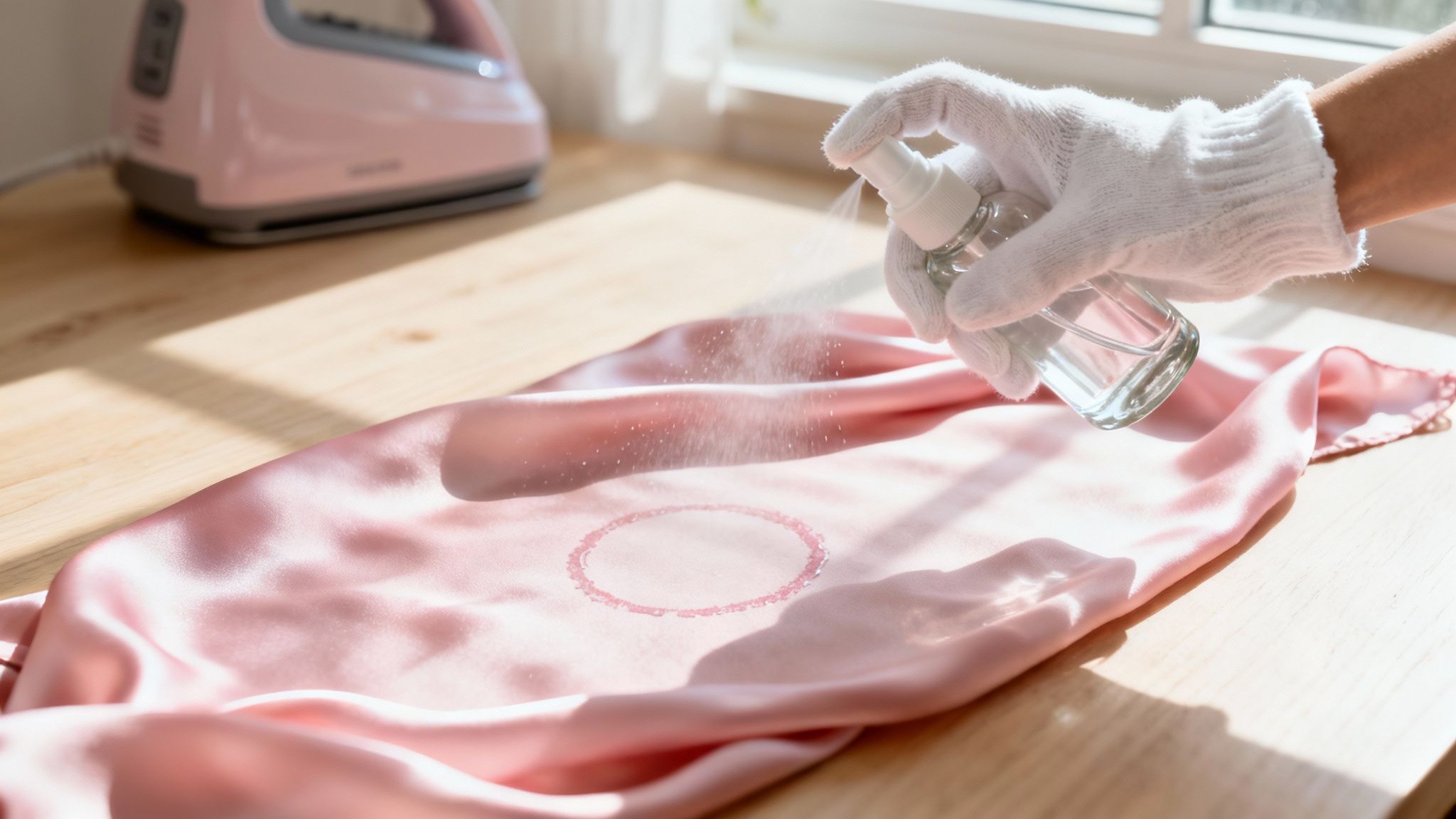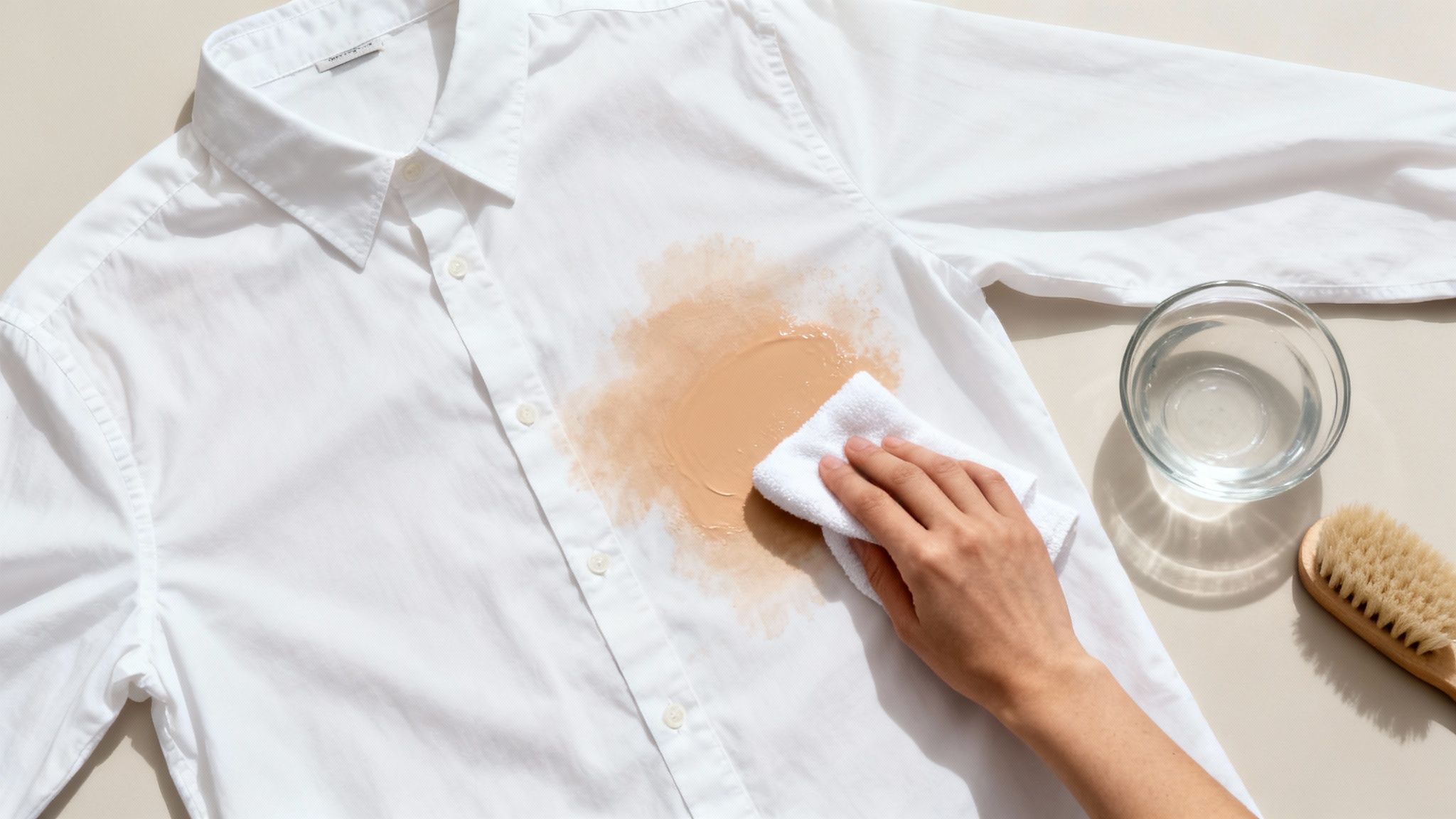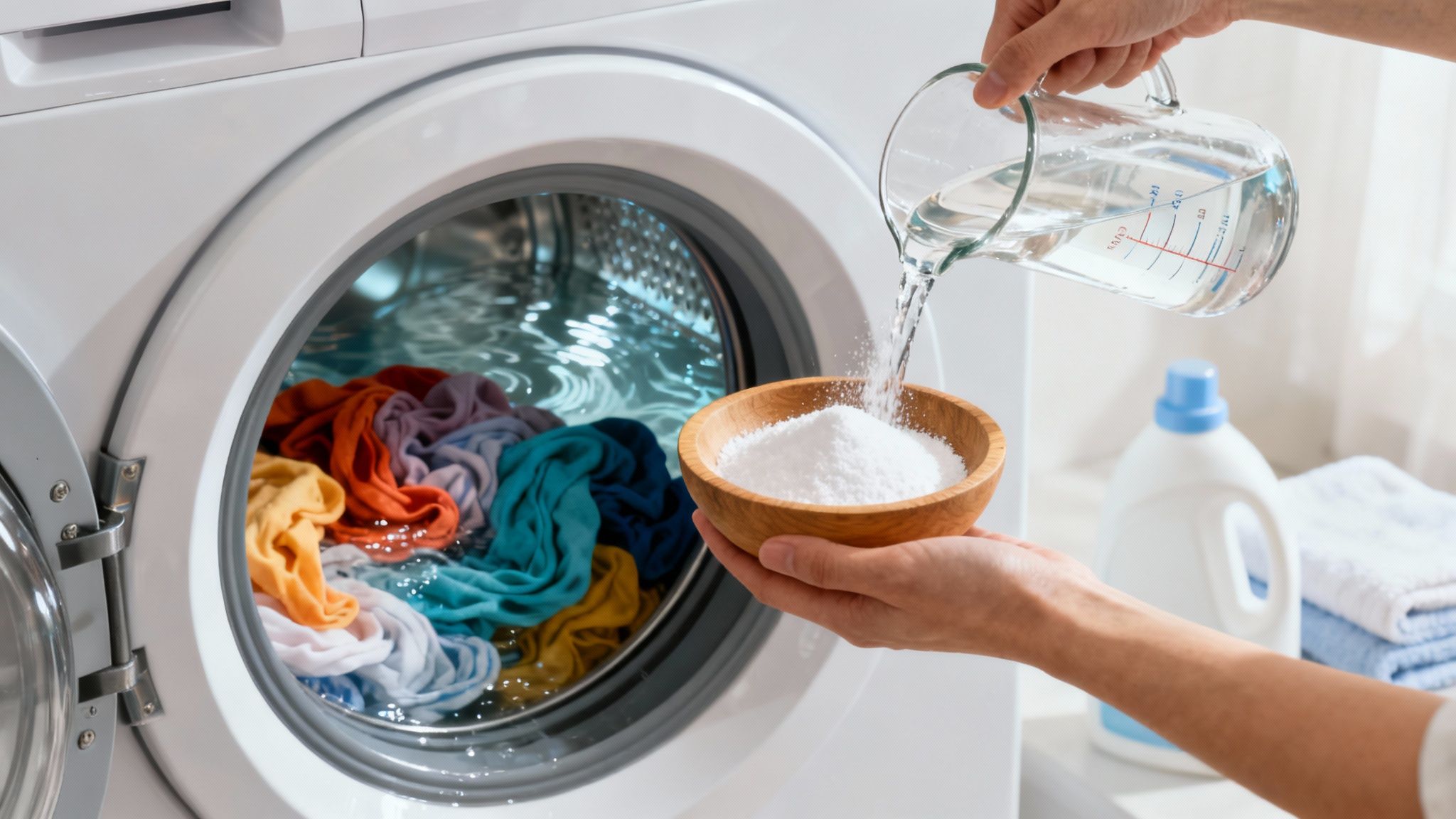How to Remove Armpit Stains on Shirts for Good
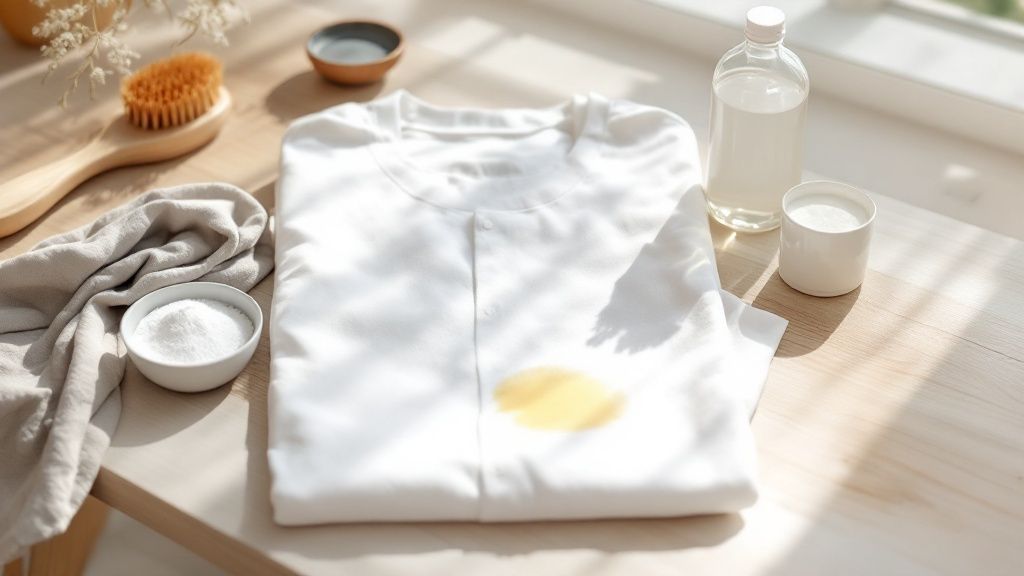
Tossing a shirt in the wash only to find those dreaded armpit stains are still there is one of laundry’s most frustrating moments. It feels like a normal wash cycle should do the trick, but it often doesn't even make a dent. That’s because you’re not just dealing with sweat.
The best methods for getting these stains out involve a pre-treatment, usually with something acidic like white vinegar or a slightly abrasive paste like baking soda and hydrogen peroxide. These work to break down the specific chemical buildup that your regular detergent can’t handle on its own.
Understanding Why Armpit Stains Form
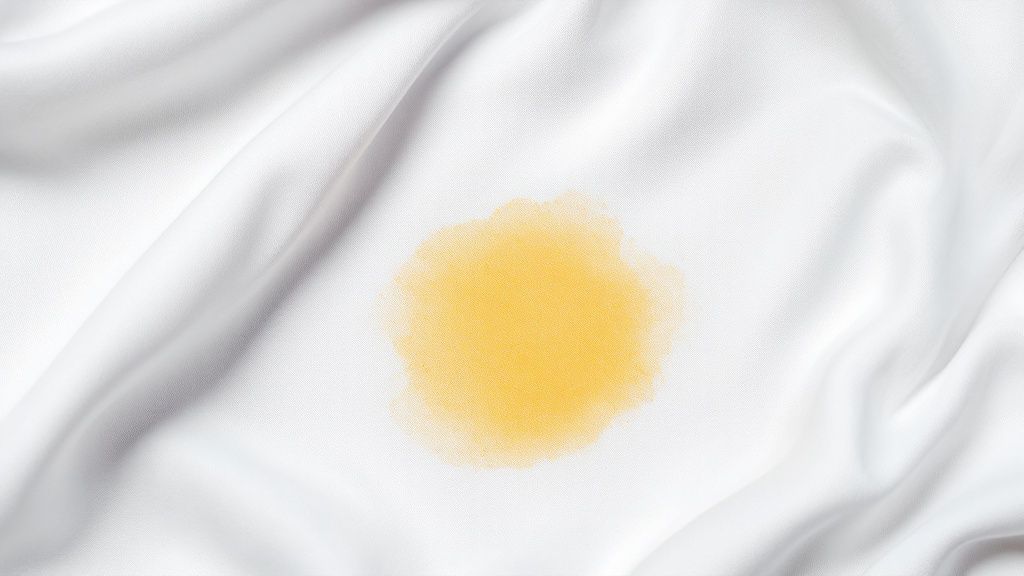
Before you can really tackle how to remove armpit stains, it helps to know what you’re up against. Those stubborn yellow marks aren't just sweat. They're actually the result of a chemical reaction.
The main culprit is almost always the aluminum compounds found in most antiperspirants. When the aluminum salts in your deodorant mix with the proteins in your sweat, they create a new compound that digs deep into the fabric's fibers. Over time, this buildup makes the fabric stiff and discolored, forming a patch that a standard wash cycle just can't penetrate.
This chemical bond explains why these stains are so notoriously tough to get out. The longer it sits, the more it fuses with the material, which can lead to some serious fabric wear and tear over time.
The Two Types of Armpit Stains
Not all pit stains are created equal. What they look like often depends on the color of your shirt, since the chemical reaction shows up differently on light versus dark fabrics.
You'll typically run into one of two problems:
- Yellow Stains on White Shirts: This is the classic. The aluminum-protein reaction creates a distinct yellow tint that gets darker and more obvious with every wear and wash.
- White, Chalky Residue on Dark Shirts: On darker clothing, the problem is usually a buildup of the deodorant product itself. The waxes, oils, and other ingredients can leave a stiff, crusty white film right on the surface.
The key takeaway is that you're not just cleaning sweat. You are breaking down a specific chemical compound that has bonded with your clothing, which requires a targeted approach.
To help you figure out what you're dealing with, here's a quick cheat sheet.
Quick Guide to Armpit Stain Types
Figuring out which type of stain you have is the first real step toward picking the right removal method and finally rescuing your favorite shirts from the donation pile.
Essential Prep Work Before You Treat a Single Stain
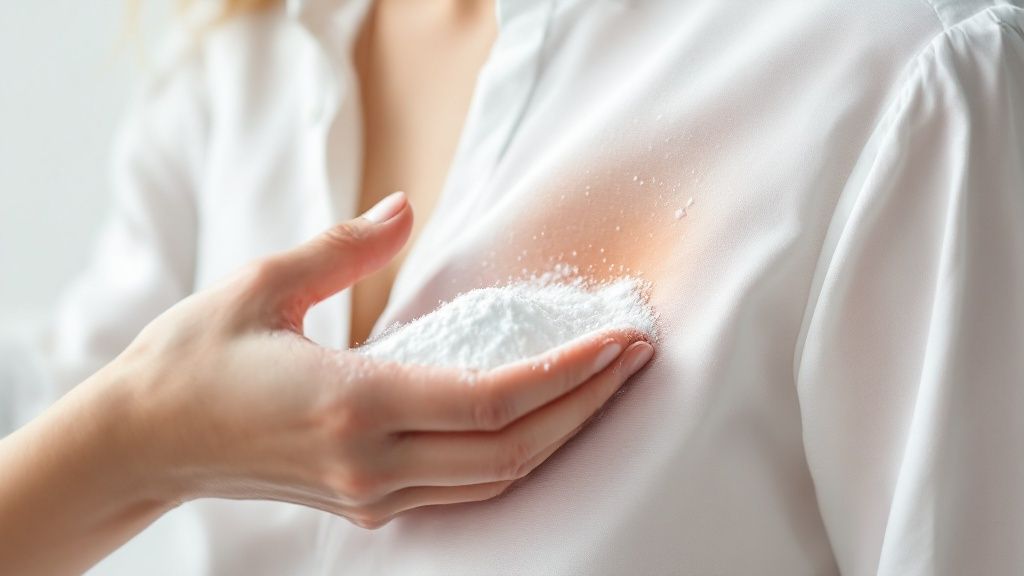
When you see that dreaded yellow stain, the first impulse is to just start scrubbing. It's a common mistake, but jumping the gun can actually lock that discoloration into the fabric for good. A few simple prep steps are going to make all the difference. Think of it as your pre-flight checklist for stain removal.
First off, always work on a completely dry shirt. Dousing a wet shirt with a stain remover just dilutes its power, making it way less effective against that stubborn mix of sweat and deodorant.
Next, flip the shirt inside out. The stain didn't just appear on the surface; it soaked through from the inside. Treating it at the source—where the sweat and deodorant concentration is highest—gives your cleaner a fighting chance to break it all down.
First, Decode the Care Label
Before you grab a single cleaning product, find that little care tag on your shirt. It’s your most important guide, telling you exactly what that specific fabric can and cannot handle. A heavy-duty cotton tee can take a much more aggressive treatment than, say, a delicate silk blouse.
Ignoring the label is a huge gamble. You might think hydrogen peroxide is a miracle worker, but using it on a "dry clean only" item could strip the color right out or damage the fibers beyond repair. This one simple step can save your favorite shirt from ruin.
The All-Important Spot Test
Once you’ve picked your stain-fighting weapon—whether it's a DIY paste or a store-bought spray—you absolutely have to do a spot test. It’s non-negotiable.
Find an inconspicuous spot, like an inner seam or the hem, and apply a tiny amount of the solution. Let it sit for a few minutes, then rinse or blot it off. If you see any color bleeding or weird texture changes, you know that method is a no-go. This quick check ensures you won't make a very visible mistake on the underarm area.
The most critical rule in stain removal is to avoid heat at all costs until the stain is completely gone. Never put a stained shirt in the dryer or use an iron on it. The high heat will bake the stain into the fabric, making it nearly impossible to ever remove.
Finally, when you do apply your cleaning solution to the stain, work it in gently. An old toothbrush or another soft-bristled brush is perfect for this. Aggressive scrubbing can easily fray the fabric and create a worn-out patch. All you need is a light, circular motion to help the cleaner penetrate the fibers without causing any collateral damage.
Powerful DIY Solutions from Your Pantry
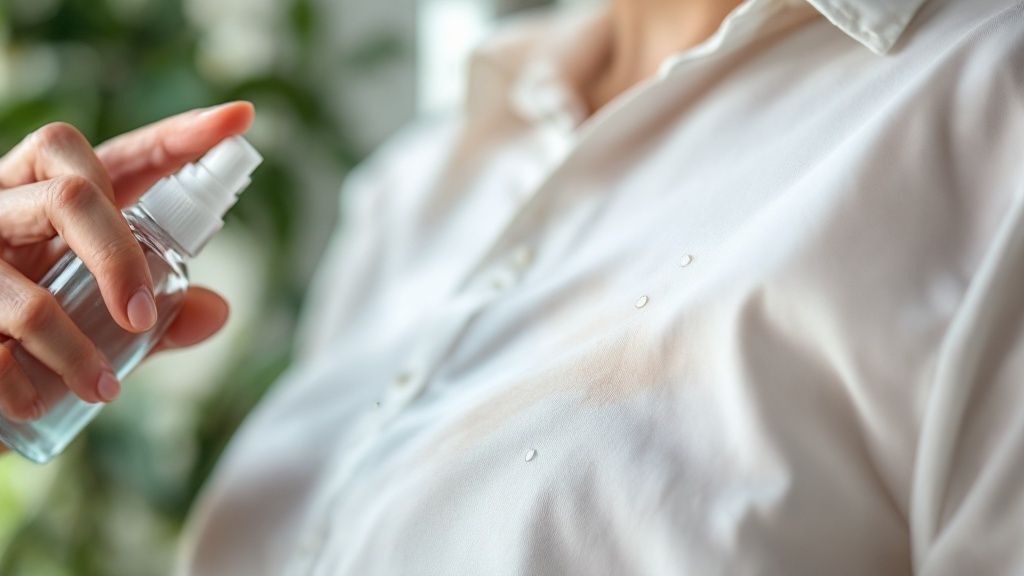
Before you head out to buy a specialized stain remover, take a quick detour to your kitchen pantry. You might be surprised to learn that some of the most effective weapons against stubborn armpit stains are probably already sitting on your shelves.
Using common household items is a fantastic way to tackle these stains. Not only is it budget-friendly, but it also means you know exactly what's going on your clothes—no harsh or mysterious chemicals involved. The trick is simply knowing which pantry hero to call on for the job, because what works on a white cotton tee might not be the best choice for your favorite black shirt.
The Baking Soda and Hydrogen Peroxide Powerhouse
For those caked-on, yellowed stains that seem to ruin every white shirt, a simple paste of baking soda and hydrogen peroxide is a classic for a reason. It's my go-to for tough discoloration. Baking soda provides a gentle scrubbing action to lift the gunk, while hydrogen peroxide works to break down the actual stain.
Just mix equal parts baking soda, hydrogen peroxide, and water to form a paste. I usually start with a tablespoon of each, which is plenty for one shirt.
- Application: Slather the paste directly onto the dry, stained underarm area.
- Dwell Time: Give it at least 30 minutes to work its magic. For really set-in stains, I'll leave it for up to an hour.
- Scrubbing: Before you wash it, grab an old toothbrush and gently scrub the paste into the fabric. Then, just launder as usual.
A quick word of caution: this combo is really best for white or very light-colored clothes made from cotton or other sturdy fabrics. Hydrogen peroxide can have a mild bleaching effect, so you'll want to be careful using it on colors.
The White Vinegar Pre-Soak for Colored Fabrics
Have you ever noticed that chalky, stiff residue that deodorant leaves behind on your dark shirts? White vinegar is your secret weapon here. Its acidity is perfect for dissolving the aluminum and other ingredients that have basically fused to the fabric fibers.
You can pour undiluted white vinegar right onto the stain, or, for a more gentle approach, make a soaking solution by mixing one part vinegar with one part water in a basin.
Pro Tip: The reason this works so well is simple chemistry. Deodorant buildup is often alkaline, and the acid in the vinegar cuts right through it, breaking down that crusty, stiff feeling.
Let the shirt soak for about 30 minutes, then gently rub the fabric against itself to work the residue loose. After that, toss it in the wash. I promise the vinegar smell will completely disappear, leaving your darks soft and residue-free.
Using Lemon Juice and Salt for Tough Cottons
If you're dealing with a really stubborn yellow stain on a durable white cotton shirt, lemon juice and salt can be a powerful natural duo. The citric acid in the lemon juice acts as a natural brightener, and the salt provides just enough abrasion to help scrub the stain away.
Squeeze some fresh lemon juice directly onto the yellowed spot and sprinkle on a little salt. Gently rub the mixture into the fabric. If you can, let the shirt sit out in the sun for an hour or two—the UV rays will actually boost the natural bleaching power of the lemon juice. Afterward, just wash it like you normally would.
Choosing the Right Commercial Stain Removers
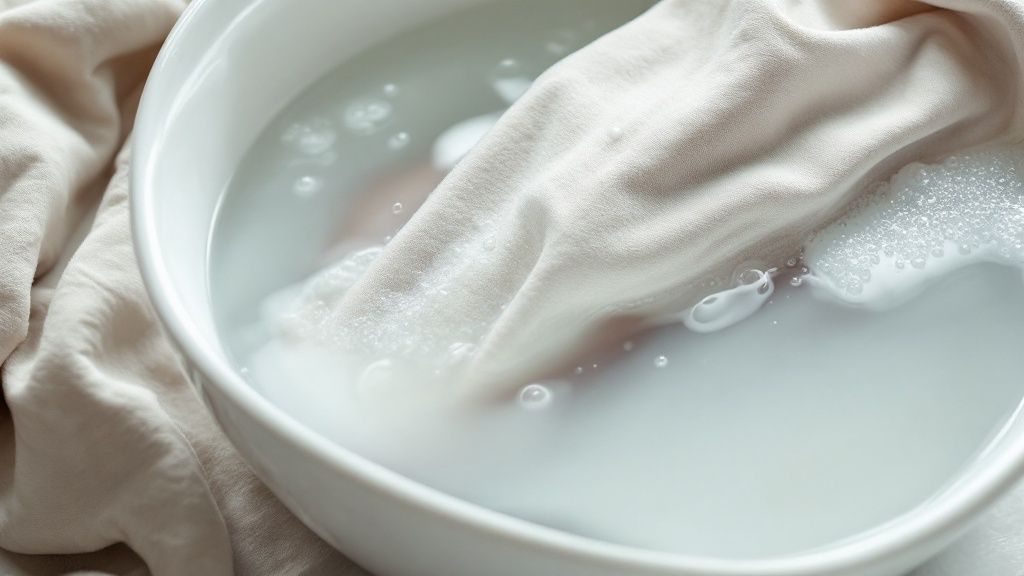
While a good pantry solution is always my first recommendation, some armpit stains are just plain stubborn. When you're dealing with set-in yellowing, it's time to bring in the big guns from the laundry aisle.
But walking down that aisle can feel overwhelming. Instead of just grabbing the first bottle you see, knowing a little bit about what's inside them makes all the difference. The goal is to find something specifically formulated to break down the proteins in sweat and the aluminum compounds from your deodorant—that's where specialized cleaners really outshine your standard detergent.
Look for Enzyme-Based Cleaners
Here's the secret weapon: enzymes. Think of them as tiny stain-fighting specialists, each designed to dismantle a specific type of mess. For those dreaded pit stains, you want to look for a product that contains protease enzymes.
Protease is engineered to go after protein-based stains, which is exactly what sweat is. These cleaners don't just cover up the stain; they literally "digest" it, lifting it right out of the fabric fibers. It's a much more effective approach than just using soap. If you want to get into the nitty-gritty of the science, we have a whole guide that explains how stain removers work for every stain type.
Harness the Power of Oxygenated Bleach
For that really tough, baked-in yellowing on white shirts, an oxygenated bleach (think OxiClean or a similar product) is your best friend. Don't confuse this with chlorine bleach! Harsh chlorine bleach can actually react with the proteins in sweat and make yellow stains even worse.
Oxygen-based cleaners work differently. They release tiny oxygen bubbles that safely lift and break apart the stain molecules without damaging the fabric's color. This makes them a fantastic, versatile option for brightening up both white and colored clothes that have gotten dingy from deodorant buildup over time.
You're not alone in this fight. The global stain remover market was valued at a whopping $16.86 billion in 2024, and it's only expected to grow. It just goes to show how common this problem is and how many effective products are now available, especially online. You can dig into the numbers in this global stain removers market report.
Sprays, Gels, or Powders: Which Is Best?
The format of the stain remover—whether it's a spray, gel, or powder—also plays a huge role. Each one has its own strengths, and choosing the right one often depends on the type of stain you're tackling.
- Sprays: These are my go-to for pre-treating fresh or surface-level stains. They're quick, cover a large area evenly, and are perfect for a fast treatment before you toss a shirt into the wash.
- Gels: Gels are ideal for older, more concentrated stains. Their thick consistency lets them cling right to the fabric, giving the active ingredients more time to soak in deep and break down that stubborn buildup.
- Powders: When you need some serious firepower, powders are the answer. Mixing them with water creates a potent soaking solution, perfect for reviving multiple garments at once or tackling severely yellowed shirts that need a good, long soak before washing.
To help you decide at a glance, here’s a quick breakdown of the most common types of commercial stain removers.
Commercial Stain Remover Comparison
Remover TypeBest ForHow It WorksFabric SafetyEnzyme SpraysFresh sweat & protein stainsProtease enzymes "digest" the biological compounds in sweatGenerally safe for most fabrics; always check the labelOxygen BleachSet-in yellow stains, dinginessReleases oxygen to break apart stain molecules & brighten fabricColor-safe; great for both whites and colorsStain Gels/SticksConcentrated, older stainsThick formula clings to fabric for deep penetrationExcellent for targeted treatment; test on an inconspicuous area firstPre-Wash SoaksHeavily soiled or multiple itemsA concentrated solution for soaking before the main wash cycleIdeal for durable fabrics like cotton and polyester
Ultimately, the best choice depends on how old and deep-set your stain is. For a newer stain, a spray might be all you need. For that favorite white t-shirt that's been yellowing for months, a good oxygen bleach soak is probably the way to go.
Proactive Tips to Prevent Future Armpit Stains
While knowing how to get those stubborn pit stains out of a shirt is a fantastic skill to have, the best strategy is always going to be prevention. Trust me, a few small tweaks to your daily routine can make a huge difference. You'll save yourself from future scrubbing sessions and keep your favorite clothes looking sharp for much, much longer.
The whole game is about stopping that stain-causing chemical reaction before it even has a chance to start.
One of the easiest habits you can pick up is simply letting your deodorant dry completely before you get dressed. When you apply it and immediately pull on a shirt, you're basically stamping the wet product directly onto the fabric. Just giving it a minute or two to absorb into your skin seriously cuts down on this residue transfer, which is the first link in the stain-formation chain.
Reconsider Your Deodorant Choice
Let's talk about the real culprit behind those tough yellow stains: the aluminum compounds found in most antiperspirants. If you're constantly battling yellowing, making the switch to an aluminum-free deodorant can be an absolute game-changer.
These products, often called natural deodorants, rely on ingredients like coconut oil or shea butter. They won't block your sweat glands, but they do a great job of managing odor and, most importantly, they eliminate the key ingredient that reacts with your sweat to create those stains. This one change alone can pretty much put an end to future yellowing.
Remember, the best defense is a good offense. Preventing stains from forming in the first place is far easier than trying to remove them once they've set deep into the fabric fibers.
Smart Laundry Habits to Stop Stains
How you care for your shirts after you wear them is just as critical. A few simple laundry habits can stop sweat and deodorant from permanently settling into the fabric.
- Wash Shirts Promptly: Don't let your sweaty gym clothes or work shirts fester in the hamper for days. The longer they sit, the more time the sweat and deodorant have to bond with the fabric, which makes stains exponentially harder to remove.
- Turn Shirts Inside Out: Before you toss a shirt in the wash, always turn it inside out. This gives the water and detergent direct access to the underarm area where all that buildup is concentrated, leading to a much more effective clean.
- Avoid Fabric Softener on Athletic Wear: This is a big one. Many fabric softeners leave behind a waxy film that can trap sweat and bacteria, especially on moisture-wicking synthetic fabrics. Over time, this can actually make discoloration and odors worse.
By weaving these simple practices into your routine, you can build a powerful defense against future stains. For a deeper dive, check out our guide on simple habits to prevent stains and keep clothes fresh. These small adjustments are the real secret to preserving your wardrobe.
Got Questions About Armpit Stains? We’ve Got Answers.
Even with the best game plan, you might still hit a snag or have a few questions pop up. Let's walk through some of the most common issues people face when tackling armpit stains, so you can handle anything that comes your way.
Can I Just Use Chlorine Bleach on My White Shirts?
It’s tempting, isn’t it? You see a yellow stain on a crisp white shirt and immediately think of reaching for the most powerful thing under the sink: chlorine bleach. But trust me, that's one of the biggest mistakes you can make.
Chlorine has a nasty chemical reaction with the proteins in your sweat and the aluminum in most antiperspirants. Instead of lifting the stain, it actually supercharges the yellowing, locking it into the fabric permanently.
The big takeaway here? Always avoid chlorine bleach for sweat stains. Stick with an oxygen-based bleach (like OxiClean) or the hydrogen peroxide and baking soda paste we talked about. They’re much safer for your shirts and way more effective.
What About Those Really Old, Set-In Stains?
Older, set-in stains are definitely a tougher nut to crack, but they’re rarely a lost cause. The key is to be patient and willing to put in a little more effort. A quick pre-treatment just won't cut it when a stain has had months or years to bond with the fabric.
Your first move should be a nice, long pre-soak. Grab a bucket or use your sink, fill it with warm water, and add a generous scoop of oxygenated bleach. Let the shirt submerge and soak for a few hours—or even better, overnight. This gives the cleaner plenty of time to get in there and start breaking down those stubborn bonds.
After the long soak, it's time for a more targeted attack:
- Whip up a thick paste using baking soda, hydrogen peroxide, and just a single drop of dish soap.
- Slather this paste right onto the still-damp stain.
- Use an old toothbrush or a soft brush to gently work the mixture into the fabric.
- Let it sit for at least an hour before you toss it in the wash.
For the most deeply set stains, don't be surprised if you need to repeat this whole process two or three times. It’s worth the effort to save a favorite shirt.
Why Do My Dark Shirts Get Those Crusty White Marks?
Ah, the dreaded white, chalky residue on dark shirts. This is a totally different issue from the yellowing on white fabrics. This isn't a chemical stain; it's a physical buildup of deodorant and antiperspirant that has literally caked onto the fibers.
To dissolve this buildup, you need something acidic. Your best friend here is plain old white vinegar. Just soak the underarm area in a one-to-one mixture of white vinegar and water for about 30 minutes before washing. The vinegar does an amazing job of breaking down all that caked-on residue. Pro tip: washing your shirts inside out can also help prevent this from happening in the first place.
Are These Methods Safe for Silks or Wools?
When you're dealing with delicate fabrics like silk, wool, or rayon, you have to pump the brakes and take a much gentler approach. Harsher treatments with hydrogen peroxide or long soaks can easily ruin these sensitive fibers.
For your delicates, always start with the mildest solution you can. Think a diluted white vinegar mix (one part vinegar to four parts water) or an enzyme cleaner that specifically says it's safe for silk and wool. And always do a spot test on a hidden area first, like an inside seam. No aggressive scrubbing, either. If the item is really expensive or has sentimental value, your safest bet is always to hand it over to a professional dry cleaner.
Battling laundry is a chore, but it doesn't have to be your chore. If you'd rather spend your time on things that matter, let Columbia Pike Laundry handle the hard work for you. We offer professional wash & fold and dry cleaning services with convenient pickup and delivery. Schedule your pickup today and reclaim your weekend.
Popular Blog Articles

Meet the Author
Daniel Logan didn’t start CPL because he loved laundry. He started it because his family was drowning in time debt, and laundry was one of the biggest weights.
Mornings were chaos with two kids under 5. Evenings felt like catch-up. And weekends? Gone to sorting socks and folding piles.
He knew his story wasn’t unique. So he built a business that gave families like his just a little bit of breathing room one load at a time.
With no laundry experience but deep tech skills, Daniel rolled up his sleeves, doing every job himself while building systems that turned it into a modern laundry service that saves customers time, simplifies their lives, and delivers reliability they can count on.
That’s where CPL began. Not from a playbook, but from pain. From one dad trying to buy back time: for himself, and for every household like his.


